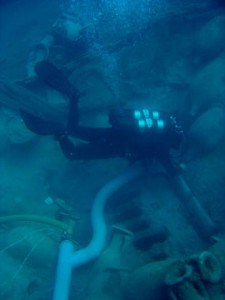
 Two thousand years ago, a Roman vessel with ingots of lead extracted from the Sierra of Cartagena sank in the waters off the coast of Sardinia. Since 2011, more than a hundred of these ingots have been used to build the Cryogenic Underground Observatory for Rare Events (CUORE), an advanced detector of neutrinos—almost weightless subatomic particles—at the Gran Sasso National Laboratory in Italy.
Two thousand years ago, a Roman vessel with ingots of lead extracted from the Sierra of Cartagena sank in the waters off the coast of Sardinia. Since 2011, more than a hundred of these ingots have been used to build the Cryogenic Underground Observatory for Rare Events (CUORE), an advanced detector of neutrinos—almost weightless subatomic particles—at the Gran Sasso National Laboratory in Italy.
In the 18th century, another ship loaded with lead ingots was wrecked on the French coast. A company of treasure hunters recently retrieved this material and, despite problems with French authorities, managed to sell it to the Cryogenic Dark Matter Search (CDMS) team. This team’s detector, located in a mine in Minnesota, looks for signs of the enigmatic “dark matter.”
These two examples have served as reference for the discussion that two researchers have opened between archaeologists, worried about the destruction of our underwater cultural heritage, and particle physicists, pleased to have found a material that is uniquely valuable for research on neutrinos and dark matter.
“Roman lead is essential for conducting these experiments because it offers purity and such low levels of radioactivity—all the more so the longer it has spent underwater—which current methods for producing this metal cannot reach,” explains Elena Perez-Alvaro from the University of Birmingham.
“Lead extracted today is naturally contaminated with the isotope Pb-210, which prevents it from being used as shielding for particle detectors,” adds physicist Fernando González Zalba from the University of Cambridge.
These two researchers have published a study in the journal Rosetta, also commented upon this month in Science, which poses a dilemma: Should we sacrifice part of our cultural heritage in order to achieve greater knowledge of the universe and the origin of humankind? Should we yield part of our past to discover more about our future?
The underwater archaeologist and the physicists are encouraging dialogue between both collectives, as well as the development of legislation that regulates these kinds of activities.
The jury is still out. In the case of the CUORE detector, for example, in principle the lead from the least well-preserved Roman ingots is used, although their inscriptions are cut and preserved. Some archaeologists also suggests that there are other pieces of valuable metal, such as anchor stocks, rings or tackles for fishing that we should assess whether or not to sacrifice for science. Further complicating the issue is the fact that these artifacts are protected by UNESCO’s 2001 Convention on the protection of underwater cultural heritage if they have been under water more than 10 years, as well as by the 2003 Convention for safeguarding intangible cultural heritage.
Regarding the use that the Romans made of these ingots, Pérez Álvaro points out that they were generally used as a water-resistant material for pipes, water tanks or roofs, and also for making arms and ammunition.
A special case is the cargo of large lead bricks recovered from the largest Roman ship of the excavation of the Mediterranean, the wreck of the Bou Ferrer, which sank very close to the port of La Vila Joiosa (Alicante). A series of engravings on the ingots (IMP. GER. AVG) have enabled specialists to determine that their owner was the Emperor of Rome himself, probably Caligula, Claudius or Nero.


Be the first to comment